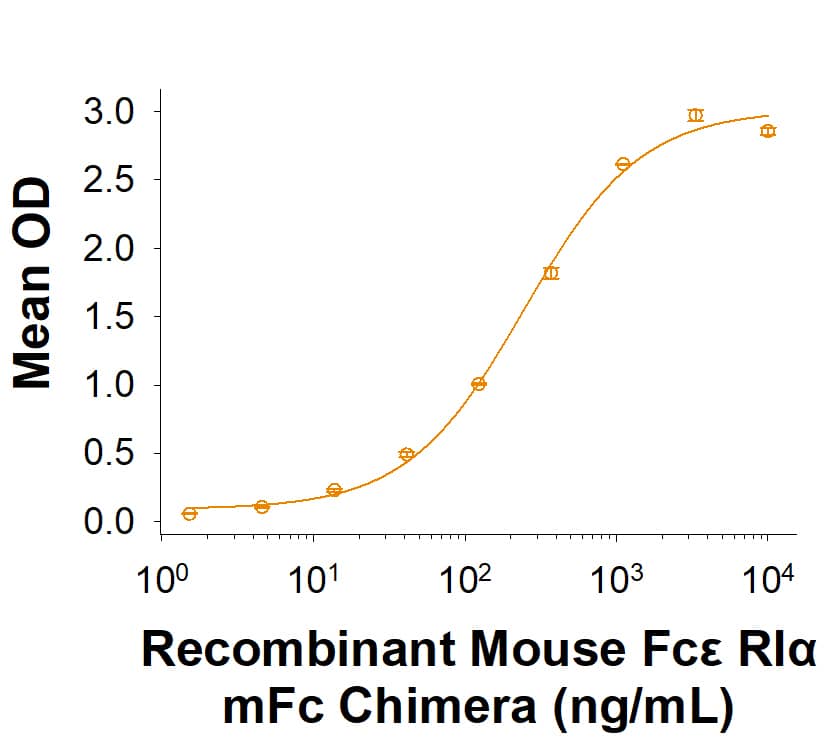Recombinant Rat CXCL3/CINC-2 beta Protein
Recombinant Rat CXCL3/CINC-2 beta Protein Summary
Product Specifications
Arg33-Leu100
Analysis
Customers also Viewed
Product Datasheets
Carrier Free
CF stands for Carrier Free (CF). We typically add Bovine Serum Albumin (BSA) as a carrier protein to our recombinant proteins. Adding a carrier protein enhances protein stability, increases shelf-life, and allows the recombinant protein to be stored at a more dilute concentration. The carrier free version does not contain BSA.
In general, we advise purchasing the recombinant protein with BSA for use in cell or tissue culture, or as an ELISA standard. In contrast, the carrier free protein is recommended for applications, in which the presence of BSA could interfere.
517-CB
| Formulation | Lyophilized from a 0.2 μm filtered solution in Acetonitrile and TFA with BSA as a carrier protein. |
| Reconstitution | Reconstitute at 50 μg/mL in sterile PBS containing at least 0.1% human or bovine serum albumin. |
| Shipping | The product is shipped at ambient temperature. Upon receipt, store it immediately at the temperature recommended below. |
| Stability & Storage: | Use a manual defrost freezer and avoid repeated freeze-thaw cycles.
|
517-CB/CF
| Formulation | Lyophilized from a 0.2 μm filtered solution in Acetonitrile and TFA. |
| Reconstitution | Reconstitute at 100 μg/mL in sterile PBS. |
| Shipping | The product is shipped at ambient temperature. Upon receipt, store it immediately at the temperature recommended below. |
| Stability & Storage: | Use a manual defrost freezer and avoid repeated freeze-thaw cycles.
|
Background: CXCL3/GRO gamma/CINC-2/DCIP-1
The rat chemokines CINC (cytokine-induced neutrophil chemoattractant)-1, CINC-2 alpha, CINC-2 beta and CINC-3 (also named MIP-2) constitute a group of rat CXC chemokines that show significant sequence similarity to human GROs and mouse MIP-2 but not IL-8. CINC-2 alpha, CINC-2 beta were originally purified as novel neutrophil chemoattractants from the conditioned medium of rat granulation tissue which also contained CINC-1 and CINC-3. Based on amino acid (aa) sequence analysis of the purified CINC-2 alpha protein and sequencing of the CINC-2 beta cDNA clone, both mature CINC-2 alpha and CINC-2 beta were shown to contain 68 aa residues. The aa sequences of the two CINC-2 proteins are identical except for three carboxy-terminal residues. CINC-2 beta cDNA encodes a 100 aa residue precursor protein with a 32 aa residue signal peptide that is removed to yield the mature secreted protein. At the protein sequence level, mature CINC-2 proteins are 63% identical to CINC-1 and 80% identical to CINC-3. CINC-2 proteins represent the major chemokines purified from conditioned medium of granulation tissue or LPS-induced inflammatory exudate. Other cell types known to produce CINC-2 proteins include activated macrophages and fibroblasts.
Recombinant and natural CINC-2 proteins have been shown to be specific neutrophil chemoattractants both in vivo and in vitro. On the basis of cross-desensitization results of the various CINC proteins, it has been postulated that rat neutrophils have at least two classes of CINC receptors: a class of CINC-3-specific receptor as well as a second common receptor shared by all CINCs.
- Nakagawa, H. et al. (1994) Biochem. J. 301:545.
- Watanabe, K. et al. (1989) J. Biol. Chem. 264:19559.
- Haskill, S. et al. (1990) Proc. Natl. Acad. Sci. USA 87:7732.
- Shibata, F. et al. (1995) Eur. J. Biochem. 231:306.
- Al-Mokdad, M. et al. (1996) Biol. Pharm. Bull. 19:879.
- Murakami, K. et al. (1997) Biochem. and Biophys. Res. Commun. 232:562.
- Watanabe, K. et al. (1991) Exp. Mol. Pathol. 55:30.
- Nakagawa, H. et al. (1996) Biochem. and Biophys. Res. Commun. 220:945.
Citation for Recombinant Rat CXCL3/CINC-2 beta Protein
R&D Systems personnel manually curate a database that contains references using R&D Systems products. The data collected includes not only links to publications in PubMed, but also provides information about sample types, species, and experimental conditions.
1 Citation: Showing 1 - 1
-
Rat coronaviruses infect rat alveolar type I epithelial cells and induce expression of CXC chemokines.
Authors: Miura TA, Wang J, Holmes KV, Mason RJ
Virology, 2007-09-05;369(2):288-98.
Applications: ELISA Developmet
FAQs
No product specific FAQs exist for this product, however you may
View all Proteins and Enzyme FAQsReviews for Recombinant Rat CXCL3/CINC-2 beta Protein
There are currently no reviews for this product. Be the first to review Recombinant Rat CXCL3/CINC-2 beta Protein and earn rewards!
Have you used Recombinant Rat CXCL3/CINC-2 beta Protein?
Submit a review and receive an Amazon gift card.
$25/€18/£15/$25CAN/¥75 Yuan/¥2500 Yen for a review with an image
$10/€7/£6/$10 CAD/¥70 Yuan/¥1110 Yen for a review without an image








